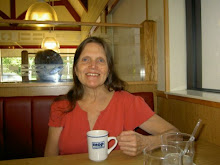
Company B
Two words: Misty Copeland!
10 more words: Misty Copeland! Misty Copeland! Misty Copeland! Misty Copeland! Misty Copeland!
Did anyone else dance? Oh yes, did they ever! There was an actual baker's dozen of dancers, hot pastries fresh from the oven: German apple strudel (Maria Ricetto and Tobin Eason), puffy popovers (Arron Scott), curvy croissants (Nicola Curry), steaming muffins (Craig Salstein with his gaggle of swooning women), bittersweet chocolate mousse (Simone Messmer and Grant DeLong), spicy hot cross buns (the Joseph! Joseph! cast), all-American brownies (Joseph Phillips) and a tangy tropical tart (Misty Copeland). Paul Taylor's rousing, lively portrayal of the devil-may-care side of World World II masking the underlayer of devastation saw its premiere in 1991, first by Houston Ballet, then by the Paul Taylor company. Like "Overgrown Path", the ballet deals with mortality, but its take on death and its inevitability is totally different. Its characters begin as innocents, knowing what war does, but in their blissful youth, refusing to believe any of it will touch them -- until it does. In their innocence, they laugh, love and flirt, play-act and have wild fun. Then bodies start dropping, creating a new reality for the revelers.
The ballet is American, the America of the Europeans who peopled its cities 75 years ago and whose sons were sent to fight for it. The jubilation begins in low light to the Yiddish "Bei Mir Bist du Schon". The entire cast of 13 make the stage sizzle with their energy. With choreography based on the swing dances of the 40s -- the lindy hop, jive, boogie-woogie -- we experience pure joy and the beauty and exuberance of the young. A spirited polka follows, a good ol' German polka. If there's anything I know something about, it's the polka, so I must say that, while very well executed by Ricetto and Eason, I can tell that neither has had extensive experience with it. Still, it was very nicely done.
"Tico-Tico", a solo for a male dancer, was performed this night by Arron Scott. An ingenious piece of choreography, the dancer isolates his upper body parts into small bits that jiggle and undulate, pop and quiver as if he were in the throes of St. Vitus Dance -- or, to be current, maybe post-traumatic stress syndrome. Scott was so good that I've got to name him as my second most memorable dancer of the evening. The second part of the solo had him doing more traditional ballet steps like jetes, but I hardly remember any of that. Daniil Simkin and, from the cast list it looks like Mikhail Ilyin, alternate the part with him at City Center.
Bespectacled Craig Salstein was such a hoot in "Oh Johnny....", so much so that I watched him instead of the girls, so cannot comment on any individual female dancer. The story line: a bunch of girls hopes the nerdy boy (who didn't have to go to war) chooses one of them, but he outruns, outjumps, and outsmarts them. Nicola Curry, a lovely adagio dancer, gives the heartache of "I Can Dream, Can't I" an aesthetic, wistfully sensuous interpretation. Just beautiful!
Joseph Phillips, replacing Herman Cornejo, tackled "Boogie Woogie Bugle Boy", a grueling athletic endeavor. Phillips is certainly up to the choreography and physical requirements, but he needs more time with the role to work on nuance and surprise. I wanted to see something special, at least once, but, aside from the whole dance making special demands on the dancer, Joseph was not able (yet) to give it a little more oomph here and there.
And then came Misty. If ever a role was made for a dancer, "Rum and Coca-Cola" was made for Misty Copeland. Exuding sass, magnetism, and intrigue with a calypso beat, she led her admiring soldier boys into a lustful frenzy. It helps that she, of all the women, looks best in the "Company B" costume, so sexy and fresh. Misty has a springy, high jump, an expansive way of moving, and sharp, precise technique. She performed this so utterly perfectly, that I wonder whether there is anyone at ABT who can touch her or even come close.
Simone Messmer and Grant DeLong were given the tail-end duet "There Will Never Be Another You". The story behind the dance is that of a couple who must part because of the call of war, ending with the soldier joining his unit and leaving his girlfriend in an emotional heap to suffer the torment of (perhaps permanent) separation. It was extremely well danced. The maturity that Messner gives us everytime she takes the stage graced this duet in smooth synchrony with DeLong's expressive partnering. Bravo! Poignantly danced and well-acted.
The return of "Bei Mir Bist du Schon" provides a summarizing coda for the piece and returns us to the festive atmosphere which took us into the ballet. The dancers all return with their vigorous energy and we are again allowed to forget.
The whole cast wore white jazz shoes for the ballet and the women wore either long skirts or trousers. The unifying accessory was a thin red belt for everyone, males and females. It is completely possible that this is a symbol of more than the blood of war. The ballet came out during the years when the AIDS crisis was on the front burner of the news constantly. Paul Taylor was deeply affected by the loss of friends and dancers and used that raw emotion as inspiration for some of his choreography. "Company B" could well be one of those works that reflected the senseless destruction wrought by the disease. There are more layers to this prickly rose of a dance than meet the eye.













No comments:
Post a Comment